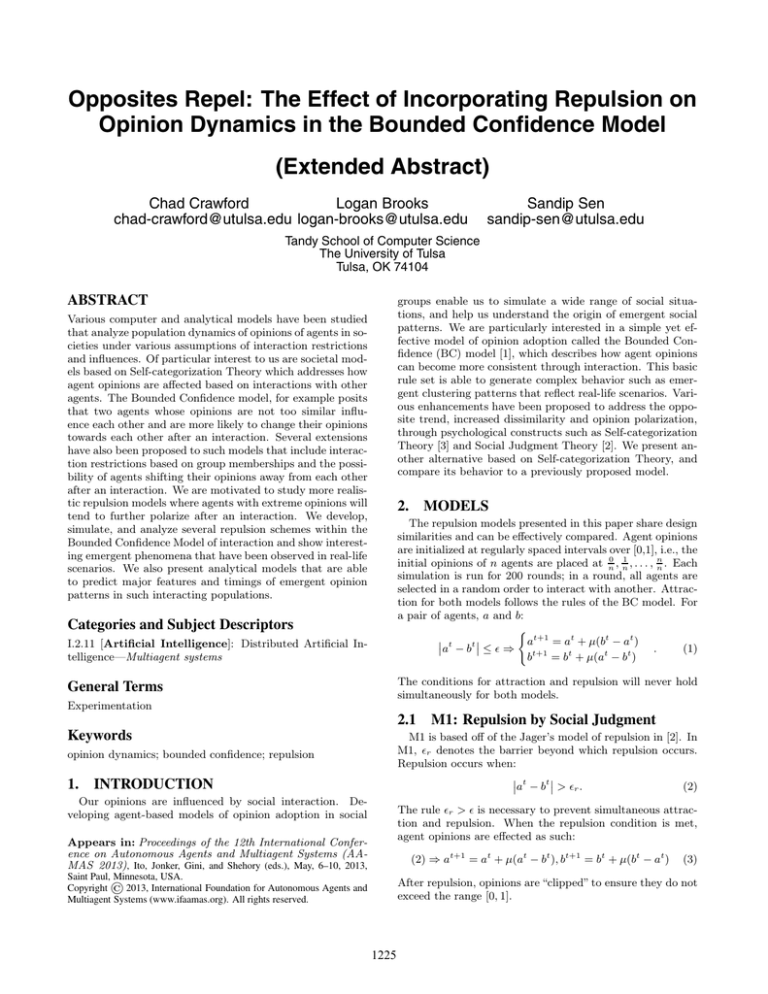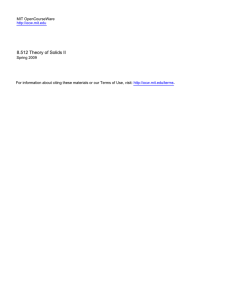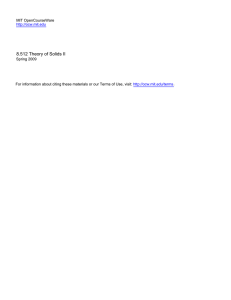
Opposites Repel: The Effect of Incorporating Repulsion on
Opinion Dynamics in the Bounded Confidence Model
(Extended Abstract)
Chad Crawford
Logan Brooks
chad-crawford@utulsa.edu logan-brooks@utulsa.edu
Sandip Sen
sandip-sen@utulsa.edu
Tandy School of Computer Science
The University of Tulsa
Tulsa, OK 74104
ABSTRACT
groups enable us to simulate a wide range of social situations, and help us understand the origin of emergent social
patterns. We are particularly interested in a simple yet effective model of opinion adoption called the Bounded Confidence (BC) model [1], which describes how agent opinions
can become more consistent through interaction. This basic
rule set is able to generate complex behavior such as emergent clustering patterns that reflect real-life scenarios. Various enhancements have been proposed to address the opposite trend, increased dissimilarity and opinion polarization,
through psychological constructs such as Self-categorization
Theory [3] and Social Judgment Theory [2]. We present another alternative based on Self-categorization Theory, and
compare its behavior to a previously proposed model.
Various computer and analytical models have been studied
that analyze population dynamics of opinions of agents in societies under various assumptions of interaction restrictions
and influences. Of particular interest to us are societal models based on Self-categorization Theory which addresses how
agent opinions are affected based on interactions with other
agents. The Bounded Confidence model, for example posits
that two agents whose opinions are not too similar influence each other and are more likely to change their opinions
towards each other after an interaction. Several extensions
have also been proposed to such models that include interaction restrictions based on group memberships and the possibility of agents shifting their opinions away from each other
after an interaction. We are motivated to study more realistic repulsion models where agents with extreme opinions will
tend to further polarize after an interaction. We develop,
simulate, and analyze several repulsion schemes within the
Bounded Confidence Model of interaction and show interesting emergent phenomena that have been observed in real-life
scenarios. We also present analytical models that are able
to predict major features and timings of emergent opinion
patterns in such interacting populations.
2. MODELS
The repulsion models presented in this paper share design
similarities and can be effectively compared. Agent opinions
are initialized at regularly spaced intervals over [0,1], i.e., the
initial opinions of n agents are placed at n0 , n1 , . . . , n
. Each
n
simulation is run for 200 rounds; in a round, all agents are
selected in a random order to interact with another. Attraction for both models follows the rules of the BC model. For
a pair of agents, a and b:
t+1
t
= at + μ(bt − at )
a − bt ≤ ⇒ a
.
(1)
t+1
b
= bt + μ(at − bt )
Categories and Subject Descriptors
I.2.11 [Artificial Intelligence]: Distributed Artificial Intelligence—Multiagent systems
The conditions for attraction and repulsion will never hold
simultaneously for both models.
General Terms
Experimentation
2.1 M1: Repulsion by Social Judgment
Keywords
M1 is based off of the Jager’s model of repulsion in [2]. In
M1, r denotes the barrier beyond which repulsion occurs.
Repulsion occurs when:
t
a − bt > r .
(2)
opinion dynamics; bounded confidence; repulsion
1.
INTRODUCTION
Our opinions are influenced by social interaction. Developing agent-based models of opinion adoption in social
The rule r > is necessary to prevent simultaneous attraction and repulsion. When the repulsion condition is met,
agent opinions are effected as such:
Appears in: Proceedings of the 12th International Conference on Autonomous Agents and Multiagent Systems (AAMAS 2013), Ito, Jonker, Gini, and Shehory (eds.), May, 6–10, 2013,
(2) ⇒ at+1 = at + μ(at − bt ), bt+1 = bt + μ(bt − at )
Saint Paul, Minnesota, USA.
Copyright © 2013, International Foundation for Autonomous Agents and
Multiagent Systems (www.ifaamas.org). All rights reserved.
(3)
After repulsion, opinions are “clipped” to ensure they do not
exceed the range [0, 1].
1225
1
appear if there is a group of agents on the interval [0, x0 ], for
some x0 > 0, such that the average opinion change for the
group is negative. When x0 < δ < ,
the average
opinion
x
3x2
change is μ2 0 0 ( − x − 2x) dx = μ2 x0 − 20 , and the
3000
"trials_opdensity.txt" using 1:2:3
2500
Opinion density
0.8
2000
0.6
1500
desired condition is satisfied for x0 > 23 . Since x0 < δ, the
minimum associated δ value is 23 . Since x0 can be increased
up to δ, we predict that the extremist group will capture all
agents on the interval [0, δ]. Analogous work predicts that
extremist groups always form when δ > , and never when
x0 > δ. Results for M1 are similar for typical configurations,
despite a small dependency on the value of μ.
0.4
1000
0.2
500
0
0
0
0.05
0.1
0.15
0.2
0.25
δ
0.3
0.35
0.4
0.45
0.5
1
3000
"trials_opdensity.txt" using 1:2:3
2500
Opinion density
0.8
3.2 Conditions for reduced variability
2000
0.6
Experiments showed that large n or small μ reduce variability in cluster position and formation. As n → ∞, the
distribution of opinion changes for agents with opinion x
will approach (almost surely) the corresponding probability
distribution. Large n population behavior can be closely approximated with a deterministic model using discrete opinionspace buckets. As μ → 0+ , continuous opinion change probability measures are more frequently sampled, and agents
will almost surely approach the mean opinion adjustment
across possible interactions.
1500
0.4
1000
0.2
500
0
0
0.5
0.55
0.6
0.65
0.7
0.75
εR
0.8
0.85
0.9
0.95
1
Figure 1: Opinion densities vs δ for M2 (top), r for
M1 (bottom), 100 runs, n = 5000, = 0.1, μ = 0.5
2.2 M2: Repulsion by Categorization
3.3 Cluster formation in M2’s middle region
Repulsion in M2 is influenced by Self-categorization Theory [4]. Individuals in the model have a personal and group
identity – the former differentiates an individual from other
individuals, the latter from other groups. Repulsion for M2
represents of the increasing salience of the group identity.
Two agents, a and b, repulse when:
(at ≤ bt ) ∧ (at < δ) ∧ (bt > 1 − δ),
Cluster formation in the middle region is very similar to
that of the BC model. In fact, parameter values in M2 can
be translated to an attraction threshold in the BC model
such that cluster positions from M2 may be mapped to the
BC model: BC = 1−2δ
, with the limitation 2 < δ < 0.5 − (where the middle region forms in M2). The result is that
the middle region for select parameter values could be mapped
to the BC model with BC . This provides an interesting outlook on how categorization and lack thereof intermingle to
reach a converged system.
(4)
assuming 2δ + < 1; which prevents simultaneous attraction
and repulsion. In other words, both agents must be in opposing groups to repulse. Repulsion is implemented through
agents offsetting their opinion by:
(4) ⇒ at+1 = at − μ 0 − at , bt+1 = bt + μ 1 − bt . (5)
3.4 Concluding Remarks
We investigate the similarities in emergent behavior of
two distinctly motivated models of opinion adoption, M1
and M2; predict (a) the presence, size, and space consumed
by extremist groups (b) the number of opinion clusters in
the converged state, and (c) the bias distribution for large
populations of agents; and explain decreased variability for
large n and low μ. The dual-group setup of M2 is limited,
but easily can be expanded to multiple groups.
Unlike M1, agents in M2 do not need to “clip” their opinions
since they will never go beyond the range [0,1].
3.
RESULTS AND DISCUSSION
Figure 1 shows that the dynamics for M1 mirror those
of M2. Regions of repulsion form in M1 when r ≥ 0.5:
agents only repulse from one extreme of the opinion spectrum. These “pseudo-groups” act like the groups in M2, yet,
groups in M1 are not as rigid as those in M2: in M2, any
member of a group may repulse from any member of an opposing group, but repulsion does not always occur between
members of pseudo-groups. The interesting similarity between these two applied social theories shows that, when
attitudes are split by only two groups, attitudinal judgment
acts identically to group judgment.
4. REFERENCES
[1] G. Deffuant, D. Neau, F. Amblard, and G. Weisbuch.
Mixing beliefs among interacting agents. Adv. Complex
Syst., 3(1–4):87–98, 2000.
[2] W. Jager and F. Amblard. Uniformity, bipolarization
and pluriformity captured as generic stylized behavior
with an agent-based simulation model of attitude
change. Computational & Mathematical Organization
Theory, 10:295–303, 2005.
[3] L. Salzarulo. A continuous opinion dynamics model
based on the principle of meta-contrast. Journal of
Artificial Societies and Social Simulation, 9:13, 2006.
[4] J. C. Turner, M. A. Hogg, P. J. Oakes, S. D. Reicher,
and M. S. Wetherell. Rediscovering the Social Group: A
Self-Categorization Theory. Basil Blackwell, 1987.
3.1 Predicting extremist group formation
For a random interaction in model M2 between agents
with opinions x and y, with (x < 1 − δ) ∧ (x < 1 − ), either y ∈ [x, x + ], and x will increase by an average of 12 μ;
y ∈ [max{0, x − }, x], and x will decrease on average by
1
μ min{x, }; y ∈ [1 − δ, 1], and x will decrease by μx; or
2
x does not change. We predict that an extremist group will
1226



